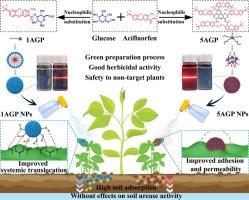基于氟醚和葡萄糖的药前自组装,以提高有效利用和降低对环境的风险
IF 13.2
1区 工程技术
Q1 ENGINEERING, CHEMICAL
引用次数: 0
摘要
除草剂以其高效、见效快、使用方便等特点,在现代农业中占有不可替代的地位。然而,由于叶片保留力差和系统转运不足,除草剂的利用率往往较低,给环境和人类健康带来了很大的风险。本研究通过酯键将氟化氟(ACI)与葡萄糖偶联,合成了两种前药(AGPs),随后通过多种非共价力自组装成AGP纳米颗粒(AGP NPs)。结果表明,不添加任何添加剂的AGP NPs具有优异的物理化学性能,包括稳定性好、表面张力低、在植物叶片上的最大保留率高。由于化学结构的变化,单体AGP NPs在植物体内表现出改善的系统转运能力,而五聚体AGP NPs则表现出增强的叶片通透性。此外,AGP NPs在温室和田间均表现出优于ACI钠盐的除草效果,其淋滤性能显著降低,对土壤脲酶活性的影响不变,对植物细胞的遗传毒性不变,对大豆幼苗具有良好的生物安全性。因此,这种药前自组装技术将为提高除草剂的有效利用和降低对环境的风险提供一种有前景的策略。本文章由计算机程序翻译,如有差异,请以英文原文为准。

Prodrug self-assemblies based on acifluorfen and glucose for improving the effective utilization and reducing the risks to environment
Herbicides hold an indispensable position in contemporary agriculture due to their characteristics of high efficiency, rapid action, and convenience. However, herbicides frequently encounter a low utilization rate resulted from poor leaf retention and inadequate systemic translocation, which poses high risks to the environment and human health. Herein, two prodrugs (AGPs) were synthesized by conjugating acifluorfen (ACI) with glucose through ester bonds and subsequently self-assembled into AGP nanoparticles (AGP NPs) through multiple noncovalent forces. The results indicated that AGP NPs without the addition of any additive exhibited exceptional physicochemical properties including good stability, low surface tension, and high maximum retention on plant leaves. Due to variation in chemical structure, monomeric AGP NPs displayed an improved systemic translocation capacity within the plant, while pentameric AGP NPs showed an enhanced leaf permeability. Additionally, AGP NPs exhibited superior herbicidal efficacies in both greenhouse and field than that of ACI sodium salt with significantly reduced leaching properties, unaltered effects on urease activity in soil, unchanged genotoxicity to plant cells, and excellent biosafety to soybean seedlings. Therefore, this prodrug self-assembly technology would provide a promising strategy for improving the effective utilization of herbicides and reducing the risks to the environment.
求助全文
通过发布文献求助,成功后即可免费获取论文全文。
去求助
来源期刊

Chemical Engineering Journal
工程技术-工程:化工
CiteScore
21.70
自引率
9.30%
发文量
6781
审稿时长
2.4 months
期刊介绍:
The Chemical Engineering Journal is an international research journal that invites contributions of original and novel fundamental research. It aims to provide an international platform for presenting original fundamental research, interpretative reviews, and discussions on new developments in chemical engineering. The journal welcomes papers that describe novel theory and its practical application, as well as those that demonstrate the transfer of techniques from other disciplines. It also welcomes reports on carefully conducted experimental work that is soundly interpreted. The main focus of the journal is on original and rigorous research results that have broad significance. The Catalysis section within the Chemical Engineering Journal focuses specifically on Experimental and Theoretical studies in the fields of heterogeneous catalysis, molecular catalysis, and biocatalysis. These studies have industrial impact on various sectors such as chemicals, energy, materials, foods, healthcare, and environmental protection.
 求助内容:
求助内容: 应助结果提醒方式:
应助结果提醒方式:


